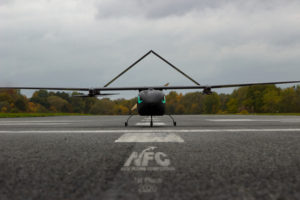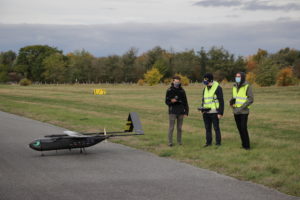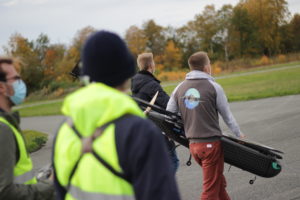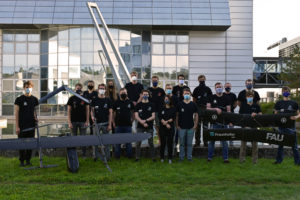Sightings of an extraordinary flying object
The TechFak EcoCar team builds an electrically powered copter
Would you like to put what you’ve learned in lectures into use in a workshop or laboratory and expand on your ideas? You can do this and more in the TechFak-EcoCar Team. Their current mission is to take over the skies with an electric aircraft.
The EcoCar team has been developing vertical take-off electric rotor aircraft for four years. They won the 2020 New Flying Competition (NFC) in Hamburg with their current copter, which is called Night Fury. In this international competition for students, teams have to design and build long-range drones that are capable of meeting the challenges of the future. These include the capacity to fly in heavily built up airspace, for example when drones are used for transportation in cities. Vertical take off and landing was therefore one of the requirements of the competition.

‘We put a total of 6,500 hours of working time into Night Fury. This is how much time it took from designing the concept, building it, the preparations for the competition and the test flight at the NFC,’ describes Adrian Sauer, who is studying for a Master’s degree in mechatronics and is team leader of TechFak-EcoCar. Night Fury was specially designed and built for the New Flying Competition in October 2020. The team had been planning on looking into vertical take off and landing for a while. ‘One of the requirements of the competition is carrying a payload of 2 kilos. The payload affects the wingspan and the geometry, and we incorporated these factors into the design of Night Fury,’ explains the EcoCar team leader.
Team surpasses requirements of competition

The drone had to fly along a certain route carrying a payload of two kilos after a vertical take off and ascending to a height of 10 meters. It then had to accelerate and fly in a circle and even loop the loop. This was followed by an efficiency test. The energy consumption of the copter during at least a 15 minute flight at a speed of 65 kilometers an hour was decisive. ‘Our copter even flew at 71 kilometers an hour and only used 128 watt-hours. That is around the same amount of energy a kettle needs to boil 1.3 liters of water. This is a really great result when you consider the copter’s size and the payload. This is probably what got us first place in the competition,’ explains Adrian. However, not only did the drone fulfill the requirements of the competition, it was also able to take off, fly, and land autonomously. Autonomous flight enables the drone to achieve the best possible flight behavior as the sensor data enable the computer to react extremely quickly to side winds or gusts, which is a major advantage in terms of efficiency. A drone like Night Fury is designed for long haul flights because of its low energy use and could thus be used as a transportation drone. ‘For example, it could be used to transport medical supplies or be used in agriculture with a thermal imaging camera to detect animals in fields,’ explains Adrian Sauer.

22 students were involved in the development of Night Fury. ‘We have people from mechanical engineering, electronics, software development and design and welcome students from all degree programs,’ emphasizes Sauer. As students have the opportunity to write their final thesis as part of the project, it is particularly popular with students from technical degree programs. During their free time, the students work in the EcoCar workshop at the Fraunhofer Institute. ‘The time students spend working on the project varies, especially if exams or a competition are coming up. Sometimes you need to work 40 hours a week, sometimes only two. But on average, each team member puts in around 10 hours of work per week into the project,’ explains Isabella Hufnagl. She is studying Computational Engineering and as PR team leader, she is responsible for the team’s Instagram and YouTube accounts as well as for the content of their website.
EcoCar takes off

The TechFak EcoCar project was set up in 2008 in cooperation with the Fraunhofer Institute for Integrated Systems and Device Technology (IISB). The student teams first built an electric car, followed by an electric motorbike called Elmo. Whilst the team members and the number of wheels for the vehicles may have changed since then, the aim of the project remains the same: making a contribution to the future of mobility using electric drives.
In addition to the infrastructure on offer, Fraunhofer also provides technical support to EcoCar. ‘We have someone who can help us with every aspect of the project if we get stuck. The same applies in the other direction as we sometimes help out at the Institute if they need support. It means we really do work together on an equal footing,’ explains Adrian, ‘and we can make some contacts for the time after university. Many former EcoCar members now work at Fraunhofer’, which demonstrates that the project drives students’ own futures forward, too.
You want more?
More information about the EcoCar team and the current projects is available on the website or on their Instagram page.
